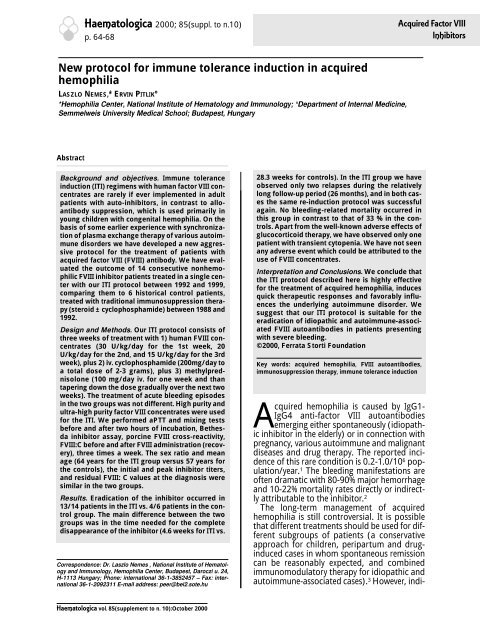Haematologica 2000;85:supplement to no. 10 - Supplements ...
Haematologica 2000;85:supplement to no. 10 - Supplements ...
Haematologica 2000;85:supplement to no. 10 - Supplements ...
Create successful ePaper yourself
Turn your PDF publications into a flip-book with our unique Google optimized e-Paper software.
<strong>Haema<strong>to</strong>logica</strong> <strong>2000</strong>; <strong>85</strong>(suppl. <strong>to</strong> n.<strong>10</strong>)<br />
p. 64-68<br />
Acquired Fac<strong>to</strong>r VIII<br />
Inhibi<strong>to</strong>rs<br />
New pro<strong>to</strong>col for immune <strong>to</strong>lerance induction in acquired<br />
hemophilia<br />
LASZLO NEMES,* ERVIN PITLIK°<br />
*Hemophilia Center, National Institute of Hema<strong>to</strong>logy and Immu<strong>no</strong>logy; °Department of Internal Medicine,<br />
Semmelweis University Medical School; Budapest, Hungary<br />
Abstract<br />
Background and objectives. Immune <strong>to</strong>lerance<br />
induction (ITI) regimens with human fac<strong>to</strong>r VIII concentrates<br />
are rarely if ever implemented in adult<br />
patients with au<strong>to</strong>-inhibi<strong>to</strong>rs, in contrast <strong>to</strong> alloantibody<br />
suppression, which is used primarily in<br />
young children with congenital hemophilia. On the<br />
basis of some earlier experience with synchronization<br />
of plasma exchange therapy of various au<strong>to</strong>immune<br />
disorders we have developed a new aggressive<br />
pro<strong>to</strong>col for the treatment of patients with<br />
acquired fac<strong>to</strong>r VIII (FVIII) antibody. We have evaluated<br />
the outcome of 14 consecutive <strong>no</strong>nhemophilic<br />
FVIII inhibi<strong>to</strong>r patients treated in a single center<br />
with our ITI pro<strong>to</strong>col between 1992 and 1999,<br />
comparing them <strong>to</strong> 6 his<strong>to</strong>rical control patients,<br />
treated with traditional immu<strong>no</strong>suppression therapy<br />
(steroid ± cyclophosphamide) between 1988 and<br />
1992.<br />
Design and Methods. Our ITI pro<strong>to</strong>col consists of<br />
three weeks of treatment with 1) human FVIII concentrates<br />
(30 U/kg/day for the 1st week, 20<br />
U/kg/day for the 2nd, and 15 U/kg/day for the 3rd<br />
week), plus 2) iv. cyclophosphamide (200mg/day <strong>to</strong><br />
a <strong>to</strong>tal dose of 2-3 grams), plus 3) methylprednisolone<br />
(<strong>10</strong>0 mg/day iv. for one week and than<br />
tapering down the dose gradually over the next two<br />
weeks). The treatment of acute bleeding episodes<br />
in the two groups was <strong>no</strong>t different. High purity and<br />
ultra-high purity fac<strong>to</strong>r VIII concentrates were used<br />
for the ITI. We performed aPTT and mixing tests<br />
before and after two hours of incubation, Bethesda<br />
inhibi<strong>to</strong>r assay, porcine FVIII cross-reactivity,<br />
FVIII:C before and after FVIII administration (recovery),<br />
three times a week. The sex ratio and mean<br />
age (64 years for the ITI group versus 57 years for<br />
the controls), the initial and peak inhibi<strong>to</strong>r titers,<br />
and residual FVIII: C values at the diag<strong>no</strong>sis were<br />
similar in the two groups.<br />
Results. Eradication of the inhibi<strong>to</strong>r occurred in<br />
13/14 patients in the ITI vs. 4/6 patients in the control<br />
group. The main difference between the two<br />
groups was in the time needed for the complete<br />
disappearance of the inhibi<strong>to</strong>r (4.6 weeks for ITI vs.<br />
Correspondence: Dr. Laszlo Nemes , National Institute of Hema<strong>to</strong>logy<br />
and Immu<strong>no</strong>logy, Hemophilia Center, Budapest, Daroczi u. 24,<br />
H-1113 Hungary; Phone: international 36-1-3<strong>85</strong>2457 – Fax: international<br />
36-1-2092311 E-mail address: peer@bel2.sote.hu<br />
28.3 weeks for controls). In the ITI group we have<br />
observed only two relapses during the relatively<br />
long follow-up period (26 months), and in both cases<br />
the same re-induction pro<strong>to</strong>col was successful<br />
again. No bleeding-related mortality occurred in<br />
this group in contrast <strong>to</strong> that of 33 % in the controls.<br />
Apart from the well-k<strong>no</strong>wn adverse effects of<br />
glucocorticoid therapy, we have observed only one<br />
patient with transient cy<strong>to</strong>penia. We have <strong>no</strong>t seen<br />
any adverse event which could be attributed <strong>to</strong> the<br />
use of FVIII concentrates.<br />
Interpretation and Conclusions. We conclude that<br />
the ITI pro<strong>to</strong>col described here is highly effective<br />
for the treatment of acquired hemophilia, induces<br />
quick therapeutic responses and favorably influences<br />
the underlying au<strong>to</strong>immune disorder. We<br />
suggest that our ITI pro<strong>to</strong>col is suitable for the<br />
eradication of idiopathic and au<strong>to</strong>immune-associated<br />
FVIII au<strong>to</strong>antibodies in patients presenting<br />
with severe bleeding.<br />
©<strong>2000</strong>, Ferrata S<strong>to</strong>rti Foundation<br />
Key words: acquired hemophilia, FVIII au<strong>to</strong>antibodies,<br />
immu<strong>no</strong>suppression therapy, immune <strong>to</strong>lerance induction<br />
Acquired hemophilia is caused by IgG1-<br />
IgG4 anti-fac<strong>to</strong>r VIII au<strong>to</strong>antibodies<br />
emerging either spontaneously (idiopathic<br />
inhibi<strong>to</strong>r in the elderly) or in connection with<br />
pregnancy, various au<strong>to</strong>immune and malignant<br />
diseases and drug therapy. The reported incidence<br />
of this rare condition is 0.2-1.0/<strong>10</strong> 6 population/year.<br />
1 The bleeding manifestations are<br />
often dramatic with 80-90% major hemorrhage<br />
and <strong>10</strong>-22% mortality rates directly or indirectly<br />
attributable <strong>to</strong> the inhibi<strong>to</strong>r. 2<br />
The long-term management of acquired<br />
hemophilia is still controversial. It is possible<br />
that different treatments should be used for different<br />
subgroups of patients (a conservative<br />
approach for children, peripartum and druginduced<br />
cases in whom spontaneous remission<br />
can be reasonably expected, and combined<br />
immu<strong>no</strong>modula<strong>to</strong>ry therapy for idiopathic and<br />
au<strong>to</strong>immune-associated cases). 3 However, indi-<br />
<strong>Haema<strong>to</strong>logica</strong> vol. <strong>85</strong>(<strong>supplement</strong> <strong>to</strong> n. <strong>10</strong>):Oc<strong>to</strong>ber <strong>2000</strong>
















